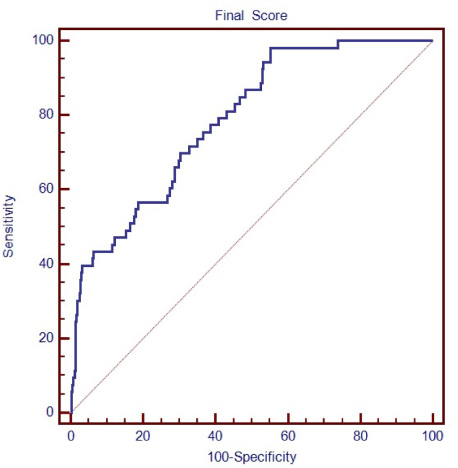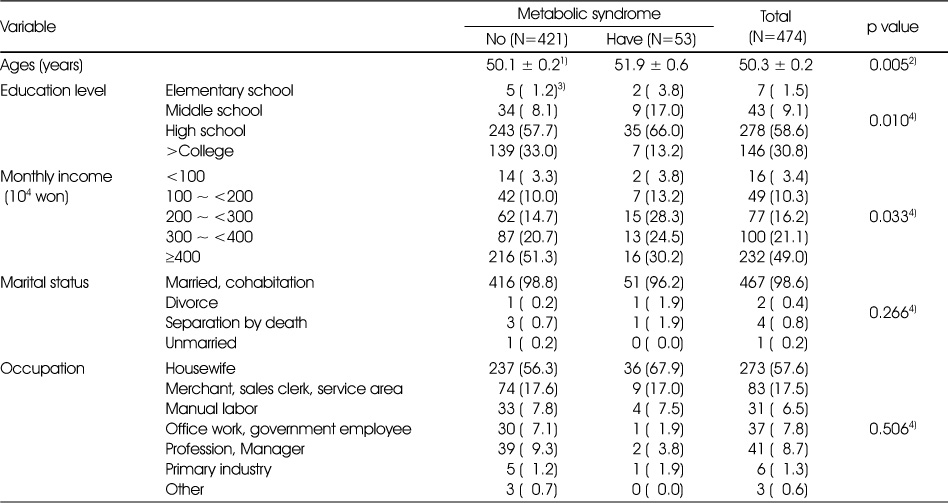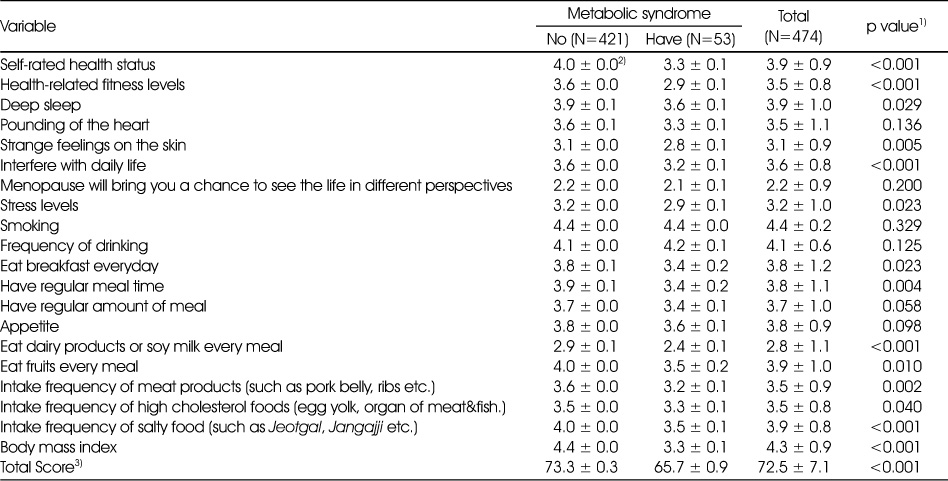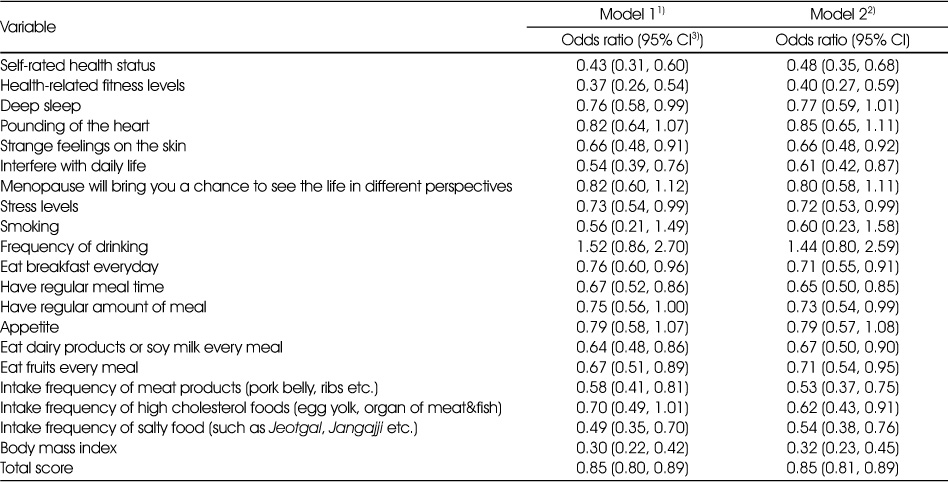Articles
- Page Path
- HOME > Korean J Community Nutr > Volume 23(4); 2018 > Article
-
Research Article
- Field Application and Evaluation of Health Status Assessment Tool based on Dietary Patterns for Middle-Aged Women
-
Hye-Jin Lee, Kyung-Hea Lee

-
Korean Journal of Community Nutrition 2018;23(4):277-288.
DOI: https://doi.org/10.5720/kjcn.2018.23.4.277
Published online: August 31, 2018
Department of Food and Nutrition, Changwon National University, Gyeongnam, Korea.
- Corresponding author: Kyung-Hea Lee. Department of Food and Nutrition, Changwon National University, 20 Changwondaehakro, Uichang-gu, Changwon, Gyeongnam, 51140, Korea. Tel: (055) 213-3514, Fax: (055) 281-7480, khl@changwon.ac.kr
Copyright © 2018 The Korean Society of Community Nutrition
This is an Open-Access article distributed under the terms of the Creative Commons Attribution Non-Commercial License (http://creativecommons.org/licenses/by-nc/3.0/) which permits unrestricted non-commercial use, distribution, and reproduction in any medium, provided the original work is properly cited.
- 948 Views
- 1 Download
- 1 Crossref
Abstract
-
Objectives
- This study was performed to verify the validity and judgment criteria setting of a health status assessment tool based on dietary patterns for middle-aged women.
-
Methods
- A total of 474 middle-aged women who visited the Comprehensive Medical Examination Center at Hanmaeum Hospital in Changwon were enrolled (IRB 2013-0005). The validity was verified using clinical indicators for the diagnosis of metabolic syndrome (MS), and it was used to set the criteria for the tool. A logistic regression analysis was performed for validation. The area under-receiver operation (AUC), sensitivity, specificity, and Youden Index were calculated through ROC curve analysis. Statistical analysis was performed by SPSS 21, and p value <0.05 was considered to be statistically significant.
-
Results
- The mean score of the group with no MS (73.3 points) was significantly higher compared to the group with MS (65.7 points) (p<0.001). An analysis of the association between the tool scores and risk of MS showed a 0.15-fold reduction in the risk of MS every time the tool's score increased by one point. As the result of the ROC curve analysis, the assessment reference point was set to 71 points, indicating 77.0% sensitivity and 61.0% specificity. Risk of MS was significantly higher in the group with a score of less than 71.0 than a group with more than 71 points (OR=5.28, p<0.001).
-
Conclusions
- This study was the first attempt to develop a health status assessment tool based on the dietary patterns for middle-aged women, and this tool has proven its usefulness as an MS assessment tool through the application of middle-aged women in the field of health screening.
Acknowledgments
Acknowledgments
- 1. Kang SW. The validity and reliability of a lifestyle evaluation tool for patients with metabolic syndrome. J Korean Acad Fundam Nurs 2010; 17(4): 487-497.
- 2. Cho B, Son KY, Oh BJ, Kim SJ, Kwon IS, Park BJ, et al. Development and validity and reliability of Korean comprehensive assessment tools for geriatric ambulatory care. J Korean Geriatr Soc 2013; 17(1): 18-27.Article
- 3. Kant AK, Schatzkin A, Ziegler RG. Dietary diversity and subsequent cause-specific mortality in the NHANES I epidemiologic follow-up study. J Am Coll Nutr 1995; 14(3): 233-238.ArticlePubMed
- 4. Drewnowski A, Henderson SA, Shore AB, Fischler C. Diet quality and dietary diversity in France: implications for the French paradox. J Am Diet Assoc 1996; 96(7): 663-669.PubMed
- 5. Koh SB, Chang SJ, Kang MG, Cha BS, Park JK. Reliability and validity on measurement instrument for health status assessment in occupational workers. Korean J Prev Med 1997; 30(2): 251-266.
- 6. Park HS, Sung SW, Ou SW, Lee KY, Kim BS, Han JH, et al. Development of Korean version of obesity-related quality of life scale. J Korean Med Obes Res 2003; 12(4): 280-293.
- 7. Park HS, Kim SK, Cho GY. A study on climacteric symptoms, depression and quality of life in middle-aged women. Korean J Women Health Nurs 2003; 9(4): 479-488.ArticlePDF
- 8. Afshari P, Barzin P, Najar S, Haghighizade M. Prevalence of chronic diseases in middle-aged women. Jundishapur J Chronic Dis Care 2014; 3(4): e23347.Article
- 9. Black PA. A smooth start to a new age: Helping women cope with the menopause. Prof Nurse 1991; 6(7): 407. 410. 412-413.PubMed
- 10. Shin HM, Jee SH, Kim JH, Kim MR. The influence on cardiovascular mortality of the metabolic syndrome in Korean postmenopausal women. J Korean Soc Menopause 2012; 18(1): 6-14.Article
- 11. Jung J, Kim NC. Risk factors, subjective symptoms, knowledge of coronary artery disease and preventive health practices in postmenopausal women. Korean J Women Health Nurs 2006; 12(1): 29-36.ArticlePDF
- 12. Lee HJ, Lee KH. Health status assessment tool development based on dietary patterns in middle-aged women. Korean J Community Nutr 2016; 21(1): 37-52.ArticlePDF
- 13. Levesque J, Lamarche B. The metabolic syndrome: definitions, prevalence and management. J Nutrigenet Nutrigenomics 2008; 1(3): 100-108.ArticlePubMedPDF
- 14. Shin HM, Jee SH, Kim JH, Kim MR. The influence on cardiovascular mortality of the metabolic syndrome in Korean postmenopausal women. J Korean Soc Menopause 2012; 18(1): 6-14.Article
- 15. Mottillo S, Filion KB, Genest J, Joseph L, Pilote L, Poirier P, et al. The metabolic syndrome and cardiovascular risk: a systematic review and meta-analysis. J Am Coll Cardiol 2010; 56(14): 1113-1132.PubMed
- 16. Trevisan M, Liu J, Bahsas FB, Menotti A. Syndrome X and mortality: a population-based study. Am J Epidemiol 1998; 148(10): 958-966.ArticlePubMed
- 17. Isomaa B, Almgren P, Tuomi T, Forsen B, Lahti K, Nissen M, et al. Cardiovascular morbidity and mortality associated with the metabolic syndrome. Diabetes Care 2001; 24(4): 683-689.ArticlePubMedPDF
- 18. Park YW, Zhu S, Palaniappan L, Heshka S, Carnethon MR, Heymsfield SB. The metabolic syndrome: prevalence and associated risk factor findings in the US population from the Third National Health and Nutrition Examination Survey, 1988–1994. Arch Intern Med 2003; 163(4): 427-436.ArticlePubMedPMC
- 19. Hu G, Qiao Q, Tuomilehto J, Balkau B, Borch-Johnsen K, Pyorala K. Prevalence of the metabolic syndrome and its relation to all-cause and cardiovascular mortality in nondiabetic European men and women. Arch Intern Med 2004; 164(10): 1066-1076.ArticlePubMed
- 20. National Cholesterol Education Program (NCEP) Expert Panel on Detection, Evaluation, and Treatment of High Blood Cholesterol in Adults (Adult Treatment Panel III). Grundy SM, Becker D, Clark LT, Cooper RS, Denke MA, Howard J, et al. Third report of the National Cholesterol Education Program (NCEP) expert panel on detection, evaluation, and treatment of high blood cholesterol in adults (Adult Treatment Panel III) final report. Circulation 2002; 106(25): 3143-3421.ArticlePubMed
- 21. World Health Organization western pacific region. The Asia-pacific perspective: redefining obesity and its treatment. International Obesity Task Force; 2000; cited 2013 May 1]. Available from: http://iris.wpro.who.int/bitstream/handle/10665.1/5379/0957708211_eng.pdf.
- 22. Jung HY, Sung KM. The development of healthy aging scale for middle aged women: convergent approach. J Digit Converg 2018; 16(5): 361-372.
- 23. Lee EH, Choi SS, So AY. A study on women's health status for setting up women's health nursing center and developing health program. Korean J Women Health Nurs 1999; 5(1): 119-133.ArticlePDF
- 24. Jeong GH, Yang SO, Lee KO, Pye OJ, Lee M, Baik SH, et al. Bone mineral density, health-promoting behavior, and self-efficacy in middle-aged women. Korean J Women Health Nurs 2003; 9(2): 170-178.ArticlePDF
- 25. Kim JH, Mun HS. Health perception, body image, sexual function and depression in menopausal women according to menopausal stages. J Korean Acad Nurs 2006; 36(3): 449-456.ArticlePDF
- 26. Lin JW, Caffrey JL, Chang MH, Lin YS. Sex, menopause, metabolic syndrome, and all-cause and cause-specific mortality-cohort analysis from the Third National Health and Nutrition Examination Survey. J Clin Endocrinol Metab 2010; 95(9): 4258-4267.ArticlePubMed
- 27. Kim JS, Cho BL. Association between self-perceived health status and health related behavior in routine health examines. Korean J Fam Med 2010; 31(9): 688-696.Article
- 28. Nuotio M, Tammela TL, Luukkaala T, Jylha M. Association of urgency symptoms with self-rated health, mood and functioning in an older population. Aging Clin Exp Res 2007; 19(6): 465-471.ArticlePubMedPDF
- 29. Lee HJ, Chung YJ, Kim HJ, Suh HS, Lee HS, Shim KW, et al. Determinants of self-assessed health among elderly adults. J Korean Acad Fam Med 2002; 23(10): 1210-1218.
- 30. Johnson RJ, Wolinsky FD. The structure of health status among older adults: disease, disability, functional limitation, and perceived health. J Health Soc Behav 1993; 34(2): 105-121.ArticlePubMed
- 31. Kim JH, Jin YS, Park JT, Jee YS, Kim KS, Lee H, et al. The relationship between health related physical fitness and self-perceived health status. J Korean Soc Health Educ Promot 1999; 16(1): 83-100.
- 32. Ahn CS. A study on correlation among physical fitness, diet intakes and serum lipid in middle aged women. Korean J Food Nutr 1993; 6(4): 255-267.
- 33. Katzmarzyk PT, Gagnon J, Leon AS, Skinner JS, Wilmor JH, Rao DC, et al. Fitness, fatness, and estimated coronary heart disease risk: the heritage family study. Med Sci Sports Exerc 2001; 33(4): 585-590.ArticlePubMed
- 34. Lee KJ, Chang CJ, Yoo JH, Yi YJ. Factors effecting health promoting behaviors in middle-aged women. J Korean Acad Nurs 2005; 35(3): 494-502.ArticlePDF
- 35. Suh JA, Lee KA. A study on feminist approach of cognitive psychology to menopause experiences. Korean J Woman Psychol 2002; 7(1): 15-28.
- 36. Park SE, Kim HM, Kim DH, Kim J, Cha BS, Kim DJ. The association between sleep duration and general and abdominal obesity in Koreans: data from the Korean National Health and Nutrition Examination Survey, 2001 and 2005. Obesity (Silver Spring) 2009; 17(4): 767-771.ArticlePubMedPDF
- 37. Gottlieb DJ, Redline S, Nieto FJ, Baldwin CM, Newman AB, Resnick HE, et al. Association of usual sleep duration with hypertension: the sleep heart health study. Sleep 2006; 29(8): 1009-1014.ArticlePubMed
- 38. Dew MA, Hoch CC, Buysse DJ, Monk TH, Begley AE, Houck PR, et al. Healthy older adults' sleep predicts all-cause mortality at 4 to 19 years of follow-up. Psychosom Med 2003; 65(1): 63-73.ArticlePubMed
- 39. Yaggi HK, Araujo AB, McKinlay JB. Sleep duration as a risk factor for the development of type 2 diabetes. Diabetes Care 2006; 29(3): 657-661.ArticlePubMedPDF
- 40. Lam JC, Ip MSM. Sleep & the metabolic syndrome. Indian J Med Res 2010; 131(2): 206-216.PubMed
- 41. Oh JD, Lee SY, Lee JG, Kim YJ, Kim YJ. Health behavior and metabolic syndrome. Korean J Fam Med 2009; 30(2): 120-128.Article
- 42. Park HS, Oh SW, Cho SI, Choi WH, Kim YS. The metabolic syndrome and associated lifestyle factors among South Korean adults. Int J Epidemiol 2004; 33(2): 328-336.ArticlePubMed
- 43. Hong Y, Pedersen NL, Brismar K, de Faire U. Genetic and environmental architecture of the features of the insulin-resistance syndrome. Am J Hum Genet 1997; 60(1): 143-152.PubMedPMC
- 44. Gaziano JM, Buring JE, Breslow JL, Goldhaber SZ, Rosner B, VanDenburgh M, et al. Moderate alcohol intake, increased levels of high-density lipoprotein and its subfractions, and decreased risk of myocardial infarction. N Engl J Med 1993; 329(25): 1829-1834.ArticlePubMed
- 45. Djousse L, Arnett DK, Eckfeldt JH, Province MA, Singer MR, Ellison RC. Alcohol consumption and metabolic syndrome: does the type of beverage matter? Obes Res 2004; 12(9): 1375-1385.ArticlePubMed
- 46. Lee KS, Park CY, Meng KH, Bush A, Lee SH, Lee WC, et al. The association of cigarette smoking and alcohol consumption with other cardiovascular risk factors in men from Seoul, Korea. Ann Epidemiol 1998; 8(1): 31-38.ArticlePubMed
- 47. Facchini F, Chen YD, Reaven GM. Light-to-moderate alcohol intake is associated with enhanced insulin sensitivity. Diabetes Care 1994; 17(2): 115-119.ArticlePubMedPDF
- 48. Jung JW, Shin HC, Park YW, Kim CH, Cheong SY, Sung EJ. The relationship between metabolic syndrome, stress and depression: among the 35–64 years old clients of comprehensive medical examination center in one university hospital. Korean J Health Promot Dis Prev 2004; 4(1): 10-17.
- 49. Lee MS. Relationship of the relative risks of the metabolic syndrome and dietary habits of middle-aged in Seoul. Korean J Community Nutr 2004; 9(6): 695-705.
- 50. Park J, Kweon SH, Kim YH, Jang MJ, Oh KW. Dietary behaviors related to metabolic syndrome in Korean adults. Korean J Community Nutr 2012; 17(5): 664-675.Article
- 51. Yoo JS, Jeong JI, Park CG, Kang SW, Ahn JA. Impact of life style characteristics on prevalence risk of metabolic syndrome. J Korean Acad Nurs 2009; 39(4): 594-601.ArticlePubMed
- 52. Chung HK, Kang JH, Shin MJ. Assessment for nutrient intakes in Korean women according to obesity and metabolic syndrome. Korean J Community Nutr 2010; 15(5): 694-703.
- 53. Seo KH, Lee HJ, Lim BD, Choi YJ, Oh HM, Yoon JS. Association of nutritional status with obesity by body mass index and waist circumference among hypertensive elderly patients. Korean J Community Nutr 2009; 14(6): 831-845.
- 54. Jovanovic GK, Zezelj SP, Malatestinic D, Sutic IM, Stefanac VN, Dorcic F. Diet quality of middle age and older women from Primorsko-Goranska county evaluated by healthy eating index and association with body mass index. Coll Antropol 2010; 34: Suppl 2. 155-160.PubMed
- 55. Freire RD, Cardoso MA, Gimeno SG, Ferreira SR. Dietary fat is associated with metabolic syndrome in Japanese Brazilians. Diabetes Care 2005; 28(7): 1779-1785.ArticlePubMedPDF
- 56. Devaraj S, Wang-Polagruto J, Polagruto J, Keen CL, Jialal I. High-fat, energy-dense, fast-food-style breakfast results in an increase in oxidative stress in metabolic syndrome. Metabolism 2008; 57(6): 867-870.ArticlePubMedPMC
- 57. Yoo H, Kim YH. A study on the characteristics of nutrient intake in metabolic syndrome subjects. Korean J Nutr 2008; 41(6): 510-517.
- 58. Grynberg A. Hypertension prevention: from nutrients to (fortified) foods to dietary patterns: Focus on fatty acids. J Hum Hypertens 2005; 19: Suppl 3. S25-S33.ArticlePubMedPDF
- 59. Hoffmann IS, Cubeddu LX. Salt and the metabolic syndrome. Nutr Metab Cardiovasc Dis 2009; 19(2): 123-128.ArticlePubMed
- 60. Greiner M, Pfeiffer D, Smith RD. Principles and practical application of the receiver-operating characteristic analysis for diagnostic test. Prev Vet Med 2000; 45(1-2): 23-41.PubMed
REFERENCES
Figure & Data
REFERENCES
Citations

- Association of milk and dairy product consumption with the incidence of cardio-cerebrovascular disease incidence in middle-aged and older Korean adults: a 16-year follow-up of the Korean Genome and Epidemiology Study
Yeseung Jeong, Kyung Won Lee, Hyekyeong Kim, Yuri Kim
Nutrition Research and Practice.2023; 17(6): 1225. CrossRef

Fig. 1
General informations about subjects with or without metabolic syndrome
1) Values are mean ± SE, 2) by t-test, 3) N (%), 4) by χ2-test.
Anthropometric and serum biochemical characteristics of subjects by the metabolic syndrome
1) by t-test, 2) Values are mean ± SE.
Scoring according of the assessment tool questions by metabolic syndrome
1) by t-test, 2) Values are mean ± SE, 3) Total score: sum of 20 questions.
Results of logistic regression analysis
1) Model 1: Unadjusted model, 2) Model 2: Adjustment for age, education level, monthly income, 3) CI: Confidence Interval.
ROC1) curve and cutoff points of assessment tool
1) ROC: Receiver-Operating Characteristic, 2) PPV: Positive Predictive Value, 3) NPV: Negative Predictive Value.
Forecasting check of assessment tool cut-off point
1) CI: Confidence Interval, 2) by logistic regression analysis.
1) Values are mean ± SE, 2) by t-test, 3) N (%), 4) by χ2-test.
1) by t-test, 2) Values are mean ± SE.
1) by t-test, 2) Values are mean ± SE, 3) Total score: sum of 20 questions.
1) Model 1: Unadjusted model, 2) Model 2: Adjustment for age, education level, monthly income, 3) CI: Confidence Interval.
1) ROC: Receiver-Operating Characteristic, 2) PPV: Positive Predictive Value, 3) NPV: Negative Predictive Value.
1) CI: Confidence Interval, 2) by logistic regression analysis.

 KSCN
KSCN







 Cite
Cite


